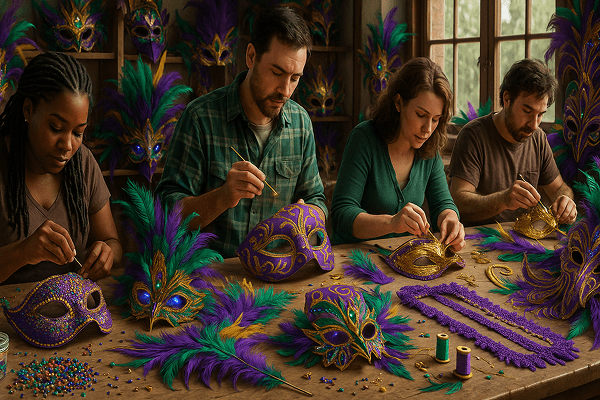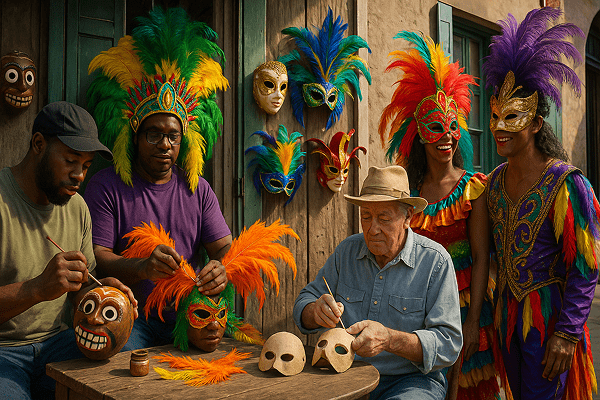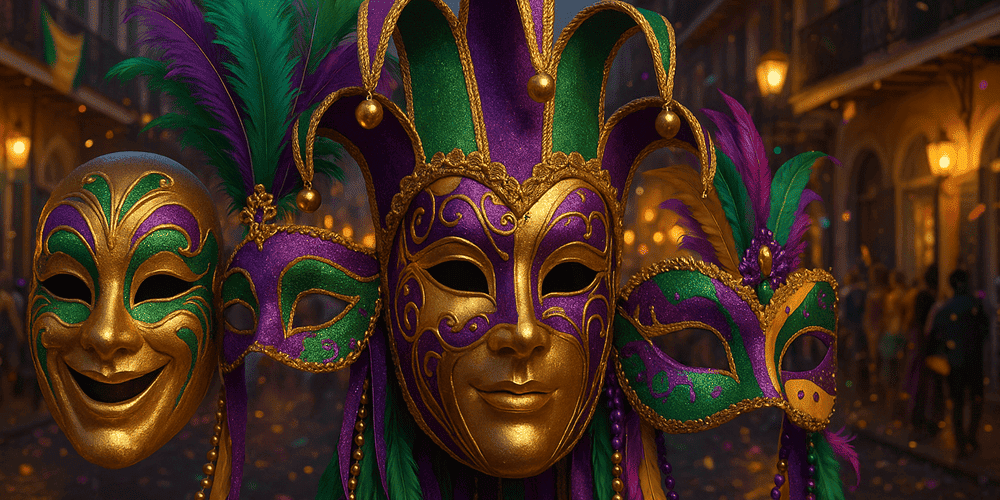Orleans Carnival Masks are vibrant, dramatic, and iconic emblems of the world-renowned Mardi Gras and Carnival celebrations in New Orleans, Louisiana. These masks are central to the visual spectacle of parades, balls, and street parties, instantly recognizable by their dazzling feathers, bold colors, elaborate glitter, sequins, beads, and intricate designs. Often worn by parade participants, krewe members, and revelers, Orleans Carnival Masks are both a symbol of the city’s multicultural heritage and a vital element in the fabric of New Orleans culture. Their roots lie in the French, Spanish, African, and Caribbean influences that have shaped New Orleans since its colonial beginnings in the early 18th century.
Historical Origins of Orleans Carnival Masks
The tradition of Orleans Carnival Masks is rooted in the European masquerade balls and Catholic pre-Lenten celebrations brought to Louisiana by French settlers. The word “Carnival” comes from the Latin “carne vale,” meaning “farewell to meat,” referring to the days of revelry before Lent. The mask, deriving from the Latin “masca” for spirit or specter, was used to allow participants to shed their everyday identity and join in the festivities as equals.
As Mardi Gras evolved in New Orleans during the 19th century, the mask became a symbol of mystery, anonymity, and playful transgression. Krewe members — the social clubs that organize parades — wore masks to conceal their identities and break down social barriers. Over time, the design and function of masks expanded, incorporating influences from African, Caribbean, and Native American masking traditions. Notable historical milestones include the founding of the Mistick Krewe of Comus in 1857, the introduction of the Zulu Social Aid & Pleasure Club’s coconut masks, and the rise of artist-designed masks in the 20th century. Today, Orleans Carnival Masks remain a powerful link to the city’s multicultural and historical legacy.
Cultural Significance and Symbolism of Orleans Carnival Masks
Orleans Carnival Masks hold deep symbolic meaning within the Mardi Gras culture. Traditionally, masks allow wearers to transcend social, racial, and economic boundaries, encouraging freedom, disguise, and uninhibited celebration. Spiritually, the mask can represent transformation, rebirth, and the temporary suspension of normal rules — a ritual inversion that echoes the ancient origins of Carnival itself.
Religious and mythological aspects are present as well: some masks channel trickster spirits, ancestral deities, or mythical creatures from African, Caribbean, or Native American cosmologies. Socially, masks provide anonymity, facilitate satire, and are used to lampoon authority or address community issues. Stories and legends — from the Zulu King to the mystical Mardi Gras Indian “Big Chiefs” — are embedded in mask designs and performances. In the broader Carnival world, similar themes are explored in events like London’s Notting Hill Carnival Masks.
Materials and Crafting Techniques of Orleans Carnival Masks
The artistry of Orleans Carnival Masks is as diverse as the city itself. Traditional masks are made from papier-mâché, wire mesh, leather, and fabric, while modern masks often incorporate lightweight plastics, foams, and innovative mixed media. The crafting process typically includes:
- Sculpting the mask base (either molded or hand-built)
- Painting and airbrushing for vibrant color
- Attaching feathers, sequins, beads, jewels, and metallic foils
- Adding ribbons, elastic, or sticks for wearing
Unique techniques include beading (inspired by Native American and African traditions), feather layering, metallic leaf application, and the use of LED lights or holographic materials for modern effects. Each krewe and artist brings their own flair, blending traditional motifs with avant-garde innovations. Color symbolism is central: purple for justice, green for faith, gold for power — the official colors of Mardi Gras. Masks are sometimes personalized with krewe emblems, initials, or references to parade themes.

For behind-the-scenes insights into mask-making, interviews with artists, and galleries of Orleans Carnival Masks, visit toddmasks.com.
Functions and Uses of Orleans Carnival Masks
The primary function of Orleans Carnival Masks is to be worn during Mardi Gras parades, balls, and street celebrations. Their uses include:
- Ritual and ceremonial: Marking the beginning of Carnival, crowning kings and queens, and leading processions.
- Theatrical: Integral to dance, music, and performance art, especially in themed balls and parades.
- Festival and holiday: Worn by parade participants, float riders, and revelers for fun, anonymity, and social commentary.
- Contemporary: Featured in art exhibitions, fashion shows, museum displays, and souvenir markets.
The use of masks has changed over time, from being exclusive to krewe members to being widely adopted by the public. Today, they are also popular as decorative art, collectibles, and symbols of New Orleans identity.
Regional Variations of Orleans Carnival Masks
While New Orleans is the epicenter, Carnival masks can vary across Louisiana and the Gulf Coast. Some regional examples include:
- Zulu coconut masks: Hand-painted and decorated by members of the Zulu Social Aid & Pleasure Club, reflecting African American heritage.
- Mardi Gras Indian masks: Elaborate, feathered headpieces and face masks worn by Black Indian krewes, inspired by Native American regalia.
- French Quarter and rural Louisiana masks: Simpler, often homemade masks reflecting rural traditions and Cajun culture.
- Influences from Caribbean and Latin American carnivals: Masks and costumes with bright colors and festival motifs.
Comparisons with masks from other global carnivals, such as those in Venice or Rio de Janeiro, reveal both shared roots and distinctive local styles.

Famous Examples and Notable Collections of Orleans Carnival Masks
Iconic Orleans Carnival Masks can be found in:
- Backstreet Cultural Museum (New Orleans): Extensive collection of Mardi Gras Indian masks and costumes.
- The Historic New Orleans Collection: Archival masks, krewe memorabilia, and artist-designed pieces.
- Louisiana State Museum: Artifacts from Mardi Gras history, including Zulu coconut masks and antique papier-mâché masks.
Private collections, krewe archives, and art galleries also showcase rare and artist-signed masks. Temporary exhibitions and parades offer a living gallery of the latest trends in mask design. For digital galleries and expert commentary, toddmasks.com provides curated selections.
Influence of Orleans Carnival Masks on Art and Culture
Orleans Carnival Masks have influenced visual arts, music, literature, and fashion. Their forms inspire painters, sculptors, costume designers, and musicians — from jazz and funk performers to opera and Broadway productions. In literature and cinema, masks symbolize the city’s mystique, resilience, and creative spirit.
Carnival mask motifs appear in New Orleans architecture, festivals, and even culinary arts. Modern designers incorporate mask imagery into jewelry, textiles, and home decor. The ongoing tradition of mask-making helps preserve New Orleans’ rich multicultural heritage, inspiring both local and global audiences.
Contemporary Status and Preservation of the Orleans Carnival Mask Tradition
Today, the tradition of Orleans Carnival Masks is more vibrant than ever. Master artisans, krewe members, and new generations collaborate in workshops, schools, and community centers. Museums and cultural organizations host mask-making classes, exhibitions, and masterclasses.
Innovations include eco-friendly materials, digital fabrication, and collaborations with visual and performance artists. Online resources like toddmasks.com connect artists, collectors, and educators, ensuring the tradition’s relevance and vitality. Preservation efforts include oral history projects, archival work, and public art initiatives.
Collecting and Acquiring Orleans Carnival Masks
The collector’s market for Orleans Carnival Masks is active and diverse. Authentic masks can be purchased from krewe members, artisan studios, museum shops, galleries, and reputable online platforms such as toddmasks.com. Prices range from inexpensive souvenirs to high-end artist pieces and historic artifacts.
Key factors influencing value include:
- Craftsmanship and originality
- Provenance and documentation
- Association with famous krewes or artists
- Rarity and historical significance
Tips for collectors: support living artisans, seek documentation, avoid mass-produced or counterfeit masks, and respect cultural heritage when acquiring older or ceremonial pieces.
